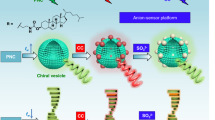Abstract
CHEMICAL indicators that change colour in response to the presence of neutral organic molecules are valuable for qualitative chemical analysis. Although some ionophores are known to exhibit colour changes on binding metal or ammonium cations1–3, however, the detection of neutral organic species in solution by this means remains problematic. We have shown recently4–7 that some fluorophore-modified cyclodextrins exhibit variations in fluorescence intensity on binding organic guests. Here we report guest-selective binding to a cyclodextrin that has been modified in such a way as to undergo a colour change on host-guest complexation. We attach the pH indicator methyl red to the wall of a β-cyclodextrin: in acidic solution, the modified cyclodextrin remains yellow owing to binding of the methyl red group inside the cavity, protecting it from protonation. When an organic guest displaces the methyl red group from the cavity, a colour change to red is observed. It should be possible to exploit the molecular recognition capability of cyclodextrins to develop a range of such 'molecular indicators'.
This is a preview of subscription content, access via your institution
Access options
Subscribe to this journal
Receive 51 print issues and online access
$199.00 per year
only $3.90 per issue
Buy this article
- Purchase on Springer Link
- Instant access to full article PDF
Prices may be subject to local taxes which are calculated during checkout
Similar content being viewed by others
References
Löhr, H. G. & Vögtle, F. Acct chem. Res. 18, 65–72 (1985).
Cram, D. J., Carmack, R. A. & Helgeson, R. C. J. Am. chem. Soc. 110, 571–577 (1988).
Kaneda, T., Umeda, S., Ishizaki, Y., Kuo, H. & Misumi, S. J. Am. chem. Soc. 111, 1881–1883 (1989).
Ueno, A., Suzuki, I. & Osa, T. J. Am. chem. Soc. 111, 6391–6397 (1989).
Ueno, A., Suzuki, I. & Osa, T. Analyt. Chem. 62, 2461–2466 (1990).
Ueno, A. et al. Chem. Lett. 605–608 (1990).
Minato, S., Osa, T. & Ueno, A. J. chem. Soc. Chem. Commun. 107–108 (1991).
Bender, M. L. & Komiyama, M. Cyclodextrin Chemistry (Springer, Berlin, 1978).
Yamamoto, S., Nishimura, N. & Hasegawa, S. Bull. chem. Soc. Jpn 46, 194–198 (1973).
Buvari, A. & Barcza, L. J. Incl. Phenom. 7, 313–320 (1989).
Harata, K. & Uedaira, H. Bull. chem. Soc. Jpn 48, 375–379 (1975).
Kodaka, M. & Fukaya, T. Bull. chem. Soc. Jpn 62, 1154–1157 (1989).
Author information
Authors and Affiliations
Rights and permissions
About this article
Cite this article
Ueno, A., Kuwabara, T., Nakamura, A. et al. A modified cyclodextrin as a guest responsive colour-change indicator. Nature 356, 136–137 (1992). https://doi.org/10.1038/356136a0
Received:
Accepted:
Issue Date:
DOI: https://doi.org/10.1038/356136a0
This article is cited by
-
Macrocycles containing azo groups: recognition, assembly and application
Journal of Inclusion Phenomena and Macrocyclic Chemistry (2018)
-
Can conversion mixture substitute beta-cyclodextrin in encapsulation of essential oils and their components?
Journal of Inclusion Phenomena and Macrocyclic Chemistry (2016)
-
Effect of Solvents and pH on β-Cyclodextrin Inclusion Complexation of 2,4-Dihydroxyazobenzene and 4-Hydroxyazobenzene
Journal of Solution Chemistry (2011)
-
Selective response of cyclodextrin-dye hydrogel to metal ions
Journal of Inclusion Phenomena and Macrocyclic Chemistry (2011)
-
Molecular recognition of aliphatic oligopeptides by aromatic diamine-bridged bis(β-cyclodextrin)
Research on Chemical Intermediates (2009)
Comments
By submitting a comment you agree to abide by our Terms and Community Guidelines. If you find something abusive or that does not comply with our terms or guidelines please flag it as inappropriate.



